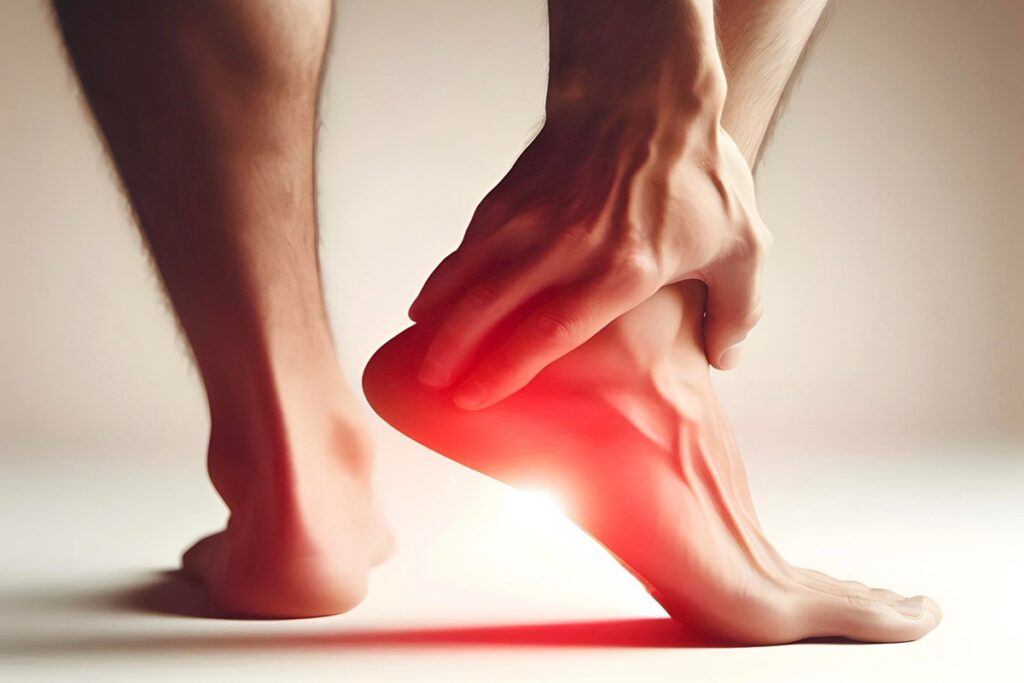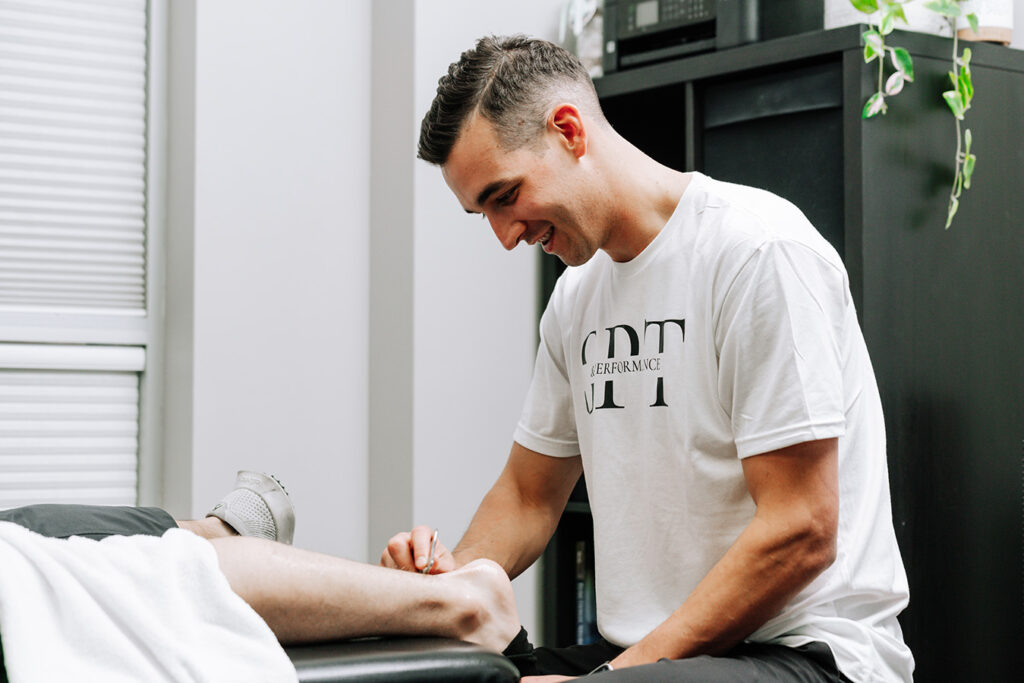Plantar fasciitis is a leading cause of heel pain among runners, CrossFit athletes, and golfers in Scottsdale. This condition, which affects the plantar fascia, a thick band of tissue supporting the arch of your foot can severely limit your ability to walk, run, or even stand for long periods. If you’re waking up with stabbing pain in your heel or struggling during weight-bearing activities, you’re not alone.
In this blog, we’ll explore how plantar fasciitis physical therapy can provide long-term relief. You’ll learn why this condition persists, how physical therapy works to heal the fascia, and what to expect when you start treatment at Scottsdale Physical Therapy & Performance.
What Is Plantar Fasciitis and Why It Happens
Plantar fasciitis develops when the plantar fascia becomes inflamed, strained, or develops micro-tears usually from overuse, poor biomechanics, or inadequate footwear. It is especially common among individuals with elevated body mass index (BMI), those who engage in repetitive activities like running, or people who stand for prolonged periods without proper foot support.
Plantar heel pain (PHP) a term now more commonly used than plantar fasciitis, represents approximately 11 to 15 percent of foot-related concerns that bring adults to seek clinical treatment. It remains one of the most frequent causes of foot pain requiring medical attention.
Understanding how the condition develops is essential for choosing the right treatment plan. Physical therapy for plantar fasciitis aims to address both the symptoms and the contributing factors like overpronation, calf muscle tightness, or poor dorsiflexion of the toes.

How the Plantar Fascia Works
The plantar fascia consists of three distinct bands that begin at the heel bone (calcaneus). These structures are critical for foot function, helping stabilize the arch, support proper biomechanics during movement, and absorb shock during walking, running, and other weight-bearing activities.
The plantar fascia runs along the bottom of your foot, connecting the heel bone (medial calcaneal tuberosity) to your toes. Its primary role is to support the foot’s arch during the gait cycle and absorb shock during weight-bearing activities. However, factors like pes planus (flat feet), pes cavus (high arches), and heel pad atrophy can place abnormal strain on this structure.
Over time, this repetitive stress can cause micro-tears of the plantar fascia. The body attempts to heal these tears, but without proper treatment such as plantar fasciitis physical therapy, inflammation continues, leading to chronic pain.
Signs & Symptoms You Shouldn’t Ignore
Common symptoms include sharp heel pain during the first steps in the morning, point tenderness near the heel, arch tightness, and difficulty walking or standing for long periods. These symptoms often worsen with prolonged standing or after high-impact activities.
Other red flags include:
- Reduced dorsiflexion of the ankle
- Pain during dorsiflexion-eversion neurodynamic test
- Positive results on the windlass test
- Pain along the medial heel where the plantar fascia inserts
Ignoring these symptoms may lead to complications like plantar calcaneal spur formation or chronic inflammation that requires more invasive intervention.
Why Heel Pain Persists Without Proper Care
Many patients often ask, does physical therapy help plantar fasciitis? The answer is yes, when properly structured, physical therapy corrects the root causes like gait dysfunction, reduced dorsiflexion, and soft tissue restrictions, offering long-term relief. Using shoe inserts or night splints may offer temporary comfort but do not replace a structured exercise regimen led by a licensed therapist.
Plantar fasciitis physical therapy uses a holistic approach, including gait assessment, manual mobilisation, and high-load strength training, to correct the underlying dysfunction. This is where true healing begins.
5 Ways Physical Therapy Helps Plantar Fasciitis
Physical therapy for plantar fasciitis is more than just stretching. It’s a clinical practice based on proven methods that reduce pain, improve function, and prevent recurrence. Here are five key ways it helps:
1. Reduces Pain Without Injections or Medications
Manual therapy techniques such as myofascial release, deep friction massage, and instrument-assisted soft tissue mobilization are used to reduce tension in the fascia and surrounding structures. Cryotherapy and low-level laser therapy may also be used to decrease inflammation.
Unlike steroid injections, which offer temporary relief, physical therapy promotes true tissue healing. Extracorporeal shock wave therapy and neuromuscular re-education are sometimes used for chronic cases to stimulate tissue repair at the cellular level.
2. Improves Flexibility in Calves and Fascia
Tight calves and Achilles tendon stiffness often contribute to plantar fasciitis. A typical PT session includes Achilles tendon stretching, gastrocnemius-soleus complex stretching, and plantar fascia-specific stretching.
These interventions are paired with manual mobilisation techniques to restore joint mobility. Improving flexibility reduces abnormal strain on the fascia and promotes better alignment during the gait cycle.
3. Strengthens Supporting Muscles
Weakness in the foot’s intrinsic muscles and the lower leg can overload the plantar fascia. Physical therapy includes high-load strength training, eccentric loading exercises, and resistance band work to build strength and neuromuscular control.
Strengthening the kinetic chain from foot to hip reduces stress on the fascia. This is especially important for individuals with a history of trauma or those returning to sports.
4. Fixes Faulty Movement Patterns
A critical part of plantar fasciitis physical therapy is identifying and correcting abnormal gait mechanics. Your therapist will conduct a thorough gait assessment and biomechanical assessment to identify areas of dysfunction.
Issues such as overpronation, flat feet, or poor push-off can be corrected through gait training and activity modification. This not only relieves current pain but also reduces your risk of recurrence.
Learn more about The role of foot mechanics.
5. Prevents Recurrence Through Education
Patient education is at the core of lasting results. At Scottsdale Physical Therapy & Performance, therapists provide tailored guidance on supportive footwear, customised foot orthoses, and home exercise plans.
Topics covered include footwear assessment, weight management for those with elevated BMI, activity modification, and self-care strategies using night splints or shoe inserts. This empowers patients to maintain their progress long-term.

What to Expect in a Physical Therapy Visit at Scottsdale PT & Performance
Our approach combines science, hands-on care, and individualized planning. Here’s what to expect when you begin your journey toward pain relief.
Your First Appointment
You’ll start with a full medical history, subjective assessment, and physical examination. This includes observation, palpation, neural examination, and diagnostic imaging (ultrasound imaging or X-ray if needed) to confirm the diagnosis.
We also conduct assessment measures like the windlass test and gait assessment to understand your movement patterns. This comprehensive evaluation ensures we address both symptoms and root causes.
Custom Treatment Plan
Your personalized care plan includes one-on-one physical therapy for plantar fasciitis tailored to your lifestyle, goals, and specific deficits. It often includes manual therapy, therapeutic taping, orthotics, and stretching programs.
A customized home exercise plan supports progress between sessions. Your therapist may also recommend supportive footwear or a night splint for nighttime pain control.
Progress You Can Measure
Most patients begin to notice improvement within 2 to 4 weeks. With consistent therapy, even chronic cases show significant recovery within 6 to 8 weeks.
Your progress is tracked through follow-up assessments and functional benchmarks such as pain during weight-bearing activities or improvements in dorsiflexion range of motion.
Common Myths About Plantar Fasciitis
“Just Rest It and It Will Go Away”
While rest can help in the acute phase, relying on it alone allows underlying biomechanical issues to persist. Structured plantar fasciitis physical therapy targets those issues through corrective exercises and gait training.
“Only Surgery Can Fix It”
Surgery is rarely needed. A systematic review of outcomes shows that conservative management, including manual therapy, eccentric loading, and customised orthotics leads to positive results in most cases.
“Insoles Are All You Need”
Insoles or over-the-counter inserts may help temporarily, but they don’t treat the root cause. Clinical practice guidelines strongly recommend physical therapy for plantar fasciitis as the first line of care.
Physical Therapy for Plantar Fasciitis Near You – Why Choose Us
If you’re searching for physical therapy for plantar fasciitis near you in Scottsdale, look no further. At Scottsdale Physical Therapy & Performance, we combine advanced sports medicine principles with personalized care.
Our therapists hold advanced certifications like FAAOMPT and TPI, bringing expertise to every session. We’ve helped hundreds of runners, CrossFitters, and golfers overcome plantar fasciitis using proven treatment methods and Physical Therapy in Scottsdale Az.
We offer flexible hours and a free consultation to help you take the first step. Request Appointment today and move pain-free.
Conclusion
Plantar fasciitis doesn’t have to control your life. With expert care, tailored exercises, and supportive education, physical therapy for plantar fasciitis can offer lasting relief. Whether you’re dealing with recurring pain or a new injury, Scottsdale PT & Performance is here to help you walk, run, and live without limitations.
FAQs
Does physical therapy help with plantar fasciitis?
Yes. Physical therapy for plantar fasciitis uses evidence-based treatments like manual therapy, gait retraining, and strengthening to resolve the underlying cause of pain and promote healing. It is highly recommended before considering more invasive treatments.
What does physical therapy for plantar fasciitis involve?
It includes a detailed physical examination, biomechanical assessment, manual mobilisation, stretching, strengthening, and patient education. Therapists also address factors like footwear, body mechanics, and activity modification.
How long does recovery take with physical therapy?
Most people see improvement within 2–4 weeks, with full recovery taking about 6–8 weeks depending on severity, compliance, and underlying conditions such as elevated BMI or poor foot mechanics.










